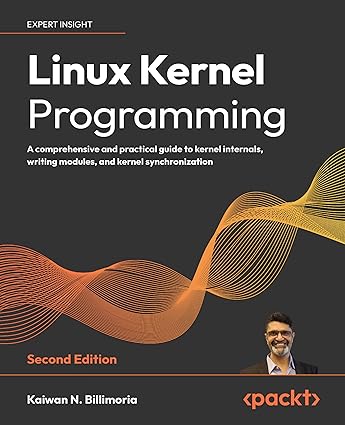Linux Kernel Programming: A Deep Dive
Introduction
The Linux kernel, the heart of the Linux operating system, is a complex piece of software that manages system resources, provides essential services, and facilitates interaction with hardware. "Linux Kernel Programming: Second Edition" offers a comprehensive guide to understanding and working with this intricate system. This white paper will delve into the key concepts covered in the book, providing a deeper understanding of kernel internals, module development, and synchronization mechanisms.
Key Concepts and Topics
1. Kernel Internals
- Kernel Architecture:
- Understanding the layered architecture of the Linux kernel, including the kernel space and user space.
- Exploring the key components like the process scheduler, memory management, and file system.
- Memory Management:
- Delving into virtual memory and physical memory management.
- Learning about page allocation, page faults, and memory reclamation.
- Process Scheduling:
- Understanding the different scheduling algorithms used by the Linux kernel.
- Exploring the concept of process states and context switching.
- File Systems:
- Examining the virtual file system (VFS) layer and its role in abstracting file system operations.
- Learning about various file systems like ext4, XFS, and Btrfs.
2. Writing Kernel Modules
- Module Lifecycle:
- Understanding the steps involved in loading and unloading kernel modules.
- Learning about module initialization and exit functions.
- Module Parameters:
- Using module parameters to configure modules at runtime.
- Kernel APIs:
- Exploring the various kernel APIs for memory allocation, task management, and file system operations.
- Debugging and Testing:
- Using kernel debugging tools like printk, dmesg, and kgdb.
- Writing effective test cases for kernel modules.
3. Kernel Synchronization
- Concurrency and Parallelism:
- Understanding the challenges of concurrent programming in the kernel.
- Learning about race conditions and deadlocks.
- Synchronization Primitives:
- Exploring various synchronization primitives like spinlocks, mutexes, semaphores, and read-write locks.
- Understanding their use cases and performance implications.
- Lock-Free Programming:
- Learning about lock-free data structures and algorithms.
- Exploring the use of atomic operations and compare-and-swap instructions.
Practical Applications and Real-World Use Cases
- Device Drivers:
- Writing device drivers for new hardware devices.
- Interfacing with hardware through kernel APIs.
- File Systems:
- Developing custom file systems for specific needs.
- Optimizing file system performance.
- Network Protocols:
- Implementing new network protocols.
- Enhancing network performance and security.
- Security Modules:
- Developing security modules to protect the kernel and system.
- Implementing access control and encryption mechanisms.
References
- Linux Kernel Programming: Second Edition by Kaiwan N. Billimoria
- The Linux Kernel Documentation: https://lwn.net/
- Kernel Newbies: https://github.com/rangaeeeee/books-raspberrypimagazines/blob/master/The%20Linux%20Programming%20Interface-Michael%20Kerrisk.pdf
- Understanding the Linux Kernel:
Conclusion
"Linux Kernel Programming: Second Edition" provides an invaluable resource for anyone interested in understanding and extending the Linux kernel. By delving into the core concepts of kernel internals, module development, and synchronization, readers can gain the skills to write efficient, reliable, and secure kernel code.



